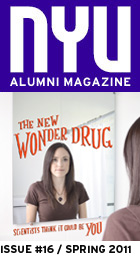publishing
Second Life
An underground hit by A film-student-turned-author goes mainstream
by Renée Alfuso / CAS ’06
Hitting bookstores this month is the paperback edition of Hilary Thayer Hamann’s debut novel, Anthropology of an American Girl, which received a starred review from Publishers Weekly that begins: “If publishers could figure out a way to turn crack into a book, it’d read a lot like this.” But it was eight years ago that Hamann (TSOA ’85, GSAS ’93) made the gutsy decision to publish the book herself—not for fear of rejection but rather in the spirit of independent artistry. She worked hard to get noticed, sending 500 galleys with letterpress covers and handwritten notes to reviewers. Although it didn’t receive national press, many college newspapers covered the book favorably and it soon became a cult hit among women, many of whom blogged about it online. After the novel sold through its first printing of some 5,000 copies in a matter of months, Hamann decided to reach out to mainstream publishers. Last year, Random House imprint Spiegel & Grau edited and released her labor of love. Hilary Thayer Hamann
Hilary Thayer Hamann
Despite its 600 pages, Anthropology is an addictive read largely because of Hamann’s poetic prose and highly detailed descriptions of life as a teenager in late 1970s East Hampton. But it isn’t the Louis Vuitton-toting, cocktail-clinking Hamptons you might find in the chick lit section; Hamann’s introspective literary style has been compared by critics to that of J.D. Salinger. The semiautobiographical story follows Eveline Auerbach as she leaves home to attend NYU, where the author herself received a BFA in film and TV production and dramatic writing, an MFA in cinema studies, and a postgraduate certificate in anthropological filmmaking. “The idea came right out of my experience at NYU,” Hamann says. “I just didn’t have a camera, so I did it with words.”
NYU Alumni Magazine sat down with the author to discuss her unusual publishing journey.
How would you describe Eveline?
For all the social noise of being 16, there’s an almost ironic internal simplicity that she has, and that I think a lot of girls have. She’s emotionally sturdy and self-contained, so she doesn’t need a lot of energy from the outside to convince her who she is and what her goals are. It’s a very brave part of a woman’s life to investigate.
Much like her, your parents divorced when you were 3 and you grew up splitting time between
the Hamptons and the Bronx. What was that like?
The Bronx is the Bronx: It was an Irish-Italian neighborhood where people slapped each other on the side of the head—it was gloriously crass and vividly real. You can’t buy that kind of experience; there’s something about it that’s so concrete and substantive, whereas my liberal mother’s lifestyle in the Hamptons was very idealistic and highly intellectual.
Parts of the book were culled from journals you’ve kept since age 14.
And now, of course, everything is done on computers, but I prefer writing [by hand]. The details weren’t too hard to
recall—people always seem amazed, like “How do you remember Wacky Packs?” I’m like, “How do you not remember Wacky Packs?”

Why do you think the first version resonated with
female readers?
At that particular time, there was a lot of so-called chick lit being published. So what was being passed off as “what women want” was lighter fare, smaller paperbacks about women in maybe more stereotypical circumstances. Mine looked really different, but it did very well. I think that might have had to do with the fact that it was an alternative and a different kind of voice that appealed to people in a new way.
What made you decide to self-publish?
[Initially] I didn’t intend to publish it—although of course, sitting there writing, I wasn’t thinking literally, no one’s ever going to read this—I just didn’t write it to fit a market to send to publishers. Being an artist from NYU, I made movies on my own, so why not make a book on my own? My then-husband had a design and print company, so we had the equipment and facilities, and we wanted to do something really high quality.
How did it feel to get such a positive response?
It was nice proof that such things can happen and that
people receiving the books wanted to share that different point of view—it was almost a renegade thing. [A few years
later] there were still women sharing stories and writing about Anthropology online, and it was being sold
on eBay.
How did the edits made by Random House change the book?
I think it’s more accessible and easily understood. The new edition is chronological whereas the original started at the end with Eveline completely compromised. I wanted the audience to judge her and then to dismantle that judgment throughout the course of the book. The original is a beautiful mess, and I wouldn’t trade it for the world. Aside from my kids, it’s probably the thing that I’m proudest of.







